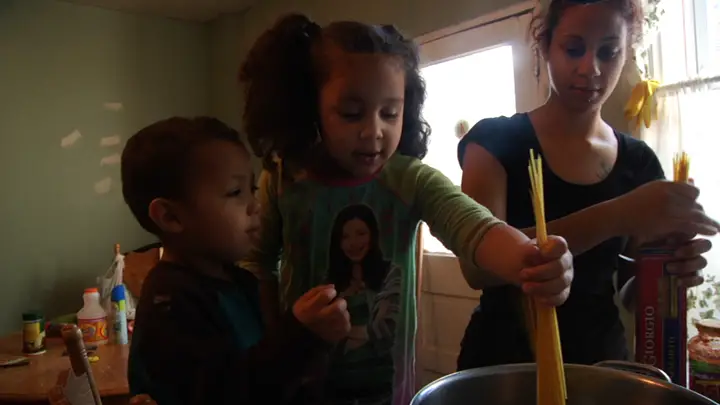A new documentary, “A Place at The Table,” shines a light on hunger in America. The film seeks to enlighten Americans that most people in the country are “food insecure”—they don’t know where their next meal is coming from.

A Place at the Table introduces us to Barbie, a Philadelphia single mom of two
struggling to make ends meet. “I feel like America has this huge stigma of how
families are supposed to eat together at a table,” Barbie says, “but they don’t talk
about what it takes to get you there. Or what’s there when you’re actually at the table.”
“Finish your meal, there are children starving in Africa!” Some version of this phrase is likely familiar to most, if not all of us. It may have been your mother’s favorite mantra at the dinner table, and it may even be something you aim at your own children when they’re being particularly resistant to polishing off the veggies on their plates. While repeating the phrase might be just an old habit, its widespread usage says something about the way we think about food. It says, “As Americans, we don’t need to worry about food.” It says, “We live in the wealthiest country in the world, and our children have plenty to eat.” It says, “Here, we don’t have hunger.” But, as a new documentary reveals, that’s simply not the case.
A Place at the Table, a Magnolia Pictures and Participant Media (Food, Inc., Waiting for “Superman”) film set to debut this month in theaters nationwide, on iTunes, and On Demand, dispels the myth that hunger does not exist in America. Through interviews with experts close to the issue as well as individuals who struggle with hunger, the documentary reveals that hunger is not the problem of a Third World country, but a very real issue for many people here in the U.S.
When we picture hunger, many of us see an emaciated child whose ribs we can easily count. But hunger and starvation are two very different things. Filmmaker Lori Silverbush, a Manhattan-based writer and director, learned the difference while mentoring a young girl named Sabrina. Sabrina’s mother was ill and out of work, and her family’s monthly allotment of food stamps lasted them only about two weeks. For the rest of the month, the family mainly subsisted on empty-calorie foods like chips and ramen noodles. Because Sabrina didn’t show any obvious physical signs of hunger, Silverbush had no idea the girl was going hungry until the principal at her school called one day to tell Silverbush that Sabrina was scavenging for scraps of food in the lunchroom trash bins. “It was shocking and heartbreaking,” Silverbush recalls. Soon after, she teamed up with documentarian Kristi Jacobson and the two set out to create a film about the paradox of widespread hunger in the world’s wealthiest nation.
A Place at the Table is the result of Silverbush and Jacobson’s year of intensive research on hunger in America, during which they realized the problem is not that there is a lack of food in our country. The problem is that millions of Americans are “food insecure,” which means they don’t know where their next meal is coming from or how they will be able to pay for it. The statistics they uncovered are staggering:
• 50 million people (1 in 6 Americans) are food insecure, and 17 million of them are children.
• 44 million Americans are on the Supplemental Nutrition Assistance Program (food stamps), and half of all children in the U.S. will be on food assistance at some point during their childhood.
• The average food stamp benefit is less than $5 per day.
• In 1980, there were 200 food banks in the U.S. Today, there are more than 40,000 food banks, soup kitchens, and food pantries.
• As many as 50 million Americans rely on charitable food programs for some part of meeting their basic food needs.
• The cost of hunger and food insecurity to the U.S. economy is $167 billion per year.
This last statistic, especially, deserves a deeper look. According to the film, that 12-figure number is linked to the cost of health care. While those who are food insecure are not dying of starvation, hunger has chronic health consequences that require long-term care. These consequences are even more severe when hunger strikes in childhood. “Any kind of nutritional deprivation, however short, can have lifelong consequences for a child,” says Mariana Chilton, Ph.D., MPH, the founder of Witnesses to Hunger, an organization that works to increase women’s participation in the national dialogue on hunger and poverty. “It affects their cogitative development, their ability to get along with others. They could be constantly sick, constantly getting infections because they’re not well nourished. It can truncate a child’s developmental potential, whether or not it affects their growth outcomes. It affects their brain on a much deeper level.”
|
One of the documentary subjects is Tremonica, a second-grader from Jonestown, MS, who suffers from a host of health problems because her diet is made up of the inexpensive, processed foods her mother can afford on her salary as a store manager. Tremonica is severely overweight, and she is an example of the fact that hunger and obesity are often present in the same person. A major reason for this puzzling fact is that processed, empty-calorie foods are more affordable than nutrient-rich foods. Since the obesity epidemic began around 1980, the relative price of fruits and vegetables has gone up 40 percent, while the price of processed foods has gone down by the same percentage.
It’s no surprise, then, that 1 in 4 children are hungry and 1 in 3 children are overweight or obese; in many cases, the same children fall into both categories. With childhood obesity comes a long list of health risks. Among other statistics, it’s projected that 1 in 3 children born in the year 2000 will develop type 2 diabetes. “People are not dying of hunger in the same way here that they are in Africa, but that’s about the best you can say,” says Raj Patel, author of Stuffed and Starved, who appears in the film.
Through Tremonica’s story and that of two other individuals who face hunger on a daily basis—Rosie, a fifth-grader from Colorado, and Barbie, a single mother of two living in Philadelphia—A Place at the Table shows how food insecurity seriously affects the health of millions of Americans, many of whom are children. The documentary also features appearances by experts and advocates in the food and nutrition field, including Joel Berg, executive director of the New York City Coalition Against Hunger; Jeff Bridges, actor and founder of the End Hunger Network; and Rep. James McGovern, co-chair for the Congressional Hunger Center, which tackles issues ranging from the stigma associated with hunger in our country to flaws in our government’s food distribution system and support services.
Ultimately, the film seeks to leave viewers contemplating an answer to this basic question: “How is it possible for a nation with so much food to have so much hunger?”
Take Action
Food Policy Action is a new organization with a mission to promote public education about food policies, reduce hunger, and encourage positive government policies by publishing the National Food Policy Scorecard. This scorecard, published online, grades government food policies and tracks the actions of government officials on those policies. Visit foodpolicyaction.org to see where your local politicians stand on food policies, learn what policies are in the works, and sign up to be notified about upcoming votes on these issues.





















